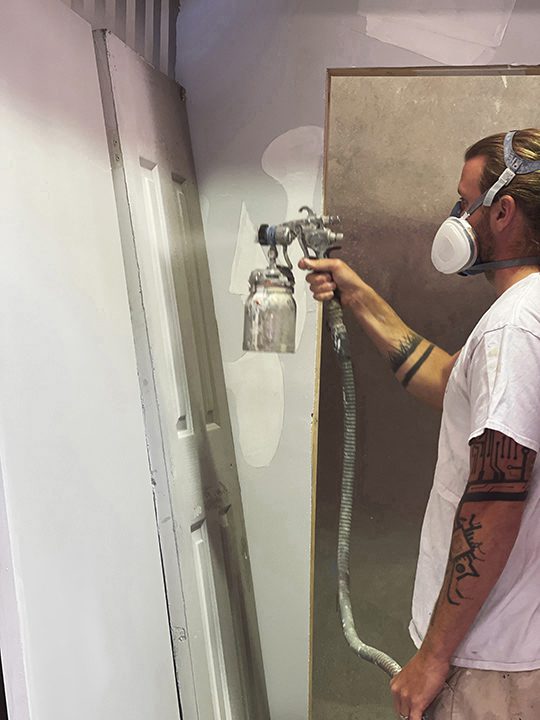Paint is the product created to provide a protective coating to the surfaces of our built environment; your home, business etc. Different types of paint provide a strengthening and decorative value, lengthening the life of a material, and improving the look and feel of a place. Predominantly manufactured in the form of a liquid that dries to a hardened surface, paints come in a huge range of differing chemical makeup based on whether they are acrylic or alkyd based. They comprise mainly of binders, pigments, additives and solvents.
Binders hold all the elements together and dry, they bond the paint to the surface. The pigment is the ingredient that determines the colour of the paint. The various additives may support the endurance of the paint and can include hardeners, mould resistance, UV screens. They may also make the product simpler to apply, and resist splashing helping to make painting cleaner and more efficient.
The solvents in house paints are used to dissolve the different compounds in the formulation such as pigment and binders to ensure it is the appropriate consistency for applying. Acrylic, vinyl and latex paints are made with water as their main ingredient hence known as acrylic or water based paints. Alkyd paints have mineral turpentine and mineral thinners as their main component and are known as enamel, oil based or solvent based paints.

Uses where and when?
When selecting the type of paint to use, the most crucial thing is what the surface is that you’re painting on. Enamel paint can be applied to an acrylic surface, however acrylic paint will not work successfully on an enamel coated surface. Acrylic can be painted on an enamel/oil based primer or enamel/oil based undercoat, ensuring that any primer or undercoat has completely dried.
Three main kinds of paint will be required:
Primers are used for the base for coating bare surfaces like timber.
Undercoat is used to seal bare areas and to coat primer before applying top coats.
Top coats overcoat both primer as well as undercoat.
It is recommended for those paints claiming to be ‘self priming’ be carefully checked on the instructions on the tin prior to application to know their limitations.

When selecting the type of paint to use, the most crucial thing is what the surface is that you’re painting on. Enamel paint can be applied to an acrylic surface, however acrylic paint will not work successfully on an enamel coated surface. Acrylic can be painted on an enamel/oil based primer or enamel/oil based undercoat, ensuring that any primer or undercoat has completely dried.
Three main kinds of paint will be required:
Primers are used for the base for coating bare surfaces like timber.
Undercoat is used to seal bare areas and to coat primer before applying top coats.
Top coats overcoat both primer as well as undercoat.
It is recommended for those paints claiming to be ‘self priming’ be carefully checked on the instructions on the tin prior to application to know their limitations.
I trained under Nigel as an apprentice, now I am happy to say my apprentice is training under him also. I really enjoyed my time on the training wheels, and to be honest, Nigel seems to be one of the few driven by passion for our trade. 5 stars, anyday.
This is the number one place to go if you have any questions to do with the painting trade. It is so heart-warming to see an organisation like this that is dedicated to help out and improve our industry. They are up-to-date with Government Legislation and forward the information on, even if you’re not a member. They are also passionate about assisting painters to better their own business to become more profitable. Aussie Painters Network deserves a 5 star rating in my book. Keep up the good work.
Very happy with the service! Great knowledge that has helped me grow and realise a few things I need to improve on.
Top site and wealth of knowledge and commitment to the guys on the tools.
I have dealt with Aussie Painters Network a few times over the years & found them to be very helpful, Polite & friendly, their magazine is always informative & even if you only get one thing from it, that’s a positive thing. Keep up the good work.
I want to take this opportunity to thank and congratulate the APN team for all the work they do to help educate, train and support our painting industry.
Well done mate…!
Aussie Painters Network
2/16 Perrin Place
Salisbury Qld 4107
We’re open 7:00 am — 3.00 pm Monday – Friday. Saturday and Sunday Closed.
For additional questions you can call us at 1800 355 344 or you can find us on 0430 399 800
Aussie Painters Network
2/16 Perrin Place
Salisbury Qld 4107
We’re open 7:00 am — 3.00 pm Monday – Friday.
Saturday and Sunday Closed.
For additional questions you can call us at 1800 355 344 or 0430 399 800
Monday – Friday : 7:00 am — 3.00 pm
Saturday and Sunday : Closed